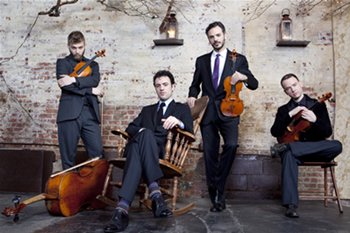Over this past weekend, we experienced two of the most powerful predators of classical music concerts: actual (or just the threat of) severe winter weather, and a major sporting event in the same general location. A string quartet is as defenseless as a wounded deer when it comes to competing with the number one religion of the Triangle area — college basketball. That was the situation when the Vega String Quartet performed at UNC Chapel Hill’s Memorial Hall while the Tar Heels played a big game across campus.
This concert was presented as part of the Music on the Hill series, which features performances by faculty and students of the UNC-Chapel Hill Department of Music. Unfortunately, this time the UNC connection was absent as originally-scheduled pianist Thomas Otten had to withdraw for medical reasons. He was replaced by William Ransom, no stranger to this state, as he serves as Artistic Director of the Highlands-Cashiers Chamber Music Festival.
The Vega String Quartet is a young group of players currently filling the position of first-ever quartet-in-residence at Emory University in Atlanta. They have gobbled up an impressive list of prizes and accolades. Their members are Wei-Wei Le and Jessica Wu, violins, Yinzi Kong, viola, and Guang Wang, cello. I feel compelled to list their names because in otherwise excellent program notes there was no mention of the individual members. Perhaps this was an intentional tactic — like the old sports cliché “there’s no ‘I’ in team” — or even socialist music coming to the very liberal Chapel Hill.
Those of us who thought we knew or at least could recognize all of the Beethoven string quartets were in for a musical education. Ludwig was savvy and protective of his compositions, and he would preempt the likelihood of other lesser composers arranging his works by doing it himself. His Piano Sonata, Op. 14, written in 1798, was arranged for string quartet by the composer in 1801. With sixteen exquisite Beethoven quartets to choose from, it is no surprise that this arrangement is rarely heard or played. Although even sub-par Beethoven is far superior to most of what was being produced contemporaneously, this was at best an interesting oddity that elicited little desire to hear it again.
While not quite as prolific as Beethoven, Béla Bartók was another composer whose output of string quartets can be used as a gauge of his artistic development. He was at the height of his artistic development and celebrity in 1928 when he composed the fourth of his six string quartets. It is a compendium of modern special effects and extreme technical demands, and the Vega Quartet played it with total confidence and remarkable clarity and precision. One of the hardest tasks for string players is to play pianissimo and prestissimo at the same time. The second movement demands this of the performers, and this quartet played it so effortlessly and clearly that it was almost arrogant in its perfection. One of the effects that originated in this Fourth Quartet and that has now become commonplace is known as the “Bartók pizzicato,” which involves snapping the string back onto the fingerboard. The obvious hazard occurred as the violist broke a string right at the end of the movement. This gave the group time to lighten the atmosphere a bit and speak to the sparse audience while Yinzi performed a string transplant. They then launched into the fifth and final movement that combines the savageness of The Rite of Spring with harmonies and scales that later “free form” jazz players unabashedly stole.
After an unusually long intermission, the quartet returned with their Emory University colleague, pianist William Ransom, for a performance of one of the most popular and beloved chamber music works — Antonín Dvorák’s Piano Quintet in A Major. Before they began playing, Ransom introduced himself and then, alluding to the violist’s broken string, proceeded to tell a string of very old, unfunny viola jokes. This was quite inappropriate and embarrassing as the quartet stared at the floor, obviously not joining in the restrained response.
My basic reaction to this performance was that the piano swallowed up the sound of the strings. This may have been a result of the scarcity of bodies soaking up the sound of the powerful Steinway, resulting in a reverb that rivaled that of Duke Chapel. At times, it seemed like a quintet for piano versus strings. When I find my attention wavering, as it did here, I try to analyze why. Well, to be honest, I’m not quite sure. Despite the acoustical problems, it was basically a well-played reading, but it definitely lacked involvement to draw in the listener. Ironically, a simple chorale and a slow inexorable drive to the finish, both near the end, seemed the most spirited. Maybe they had tickets to the second half of the basketball game.











